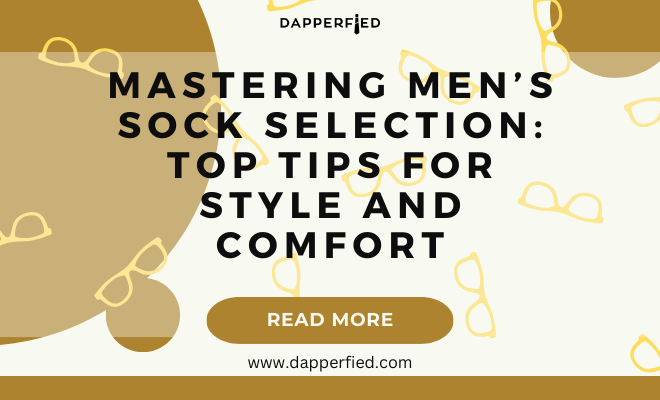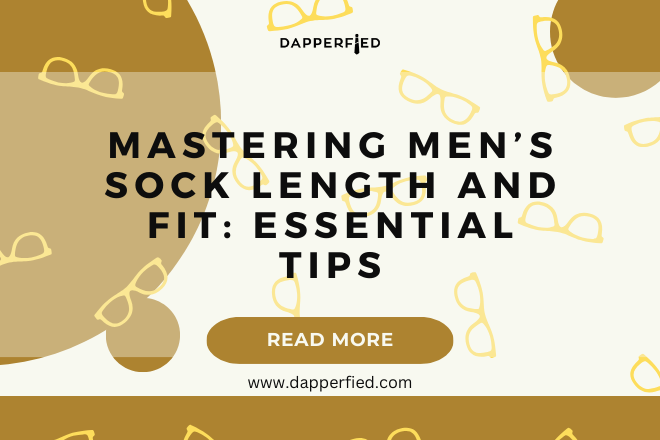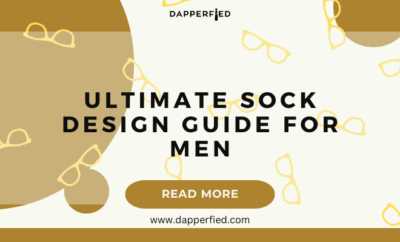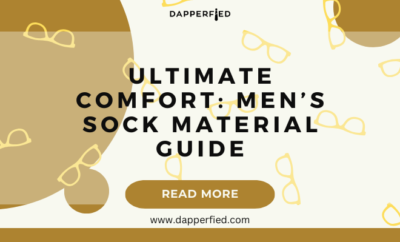
Men's Style
Mastering Men’s Sock Selection: Top Tips for Style and Comfort
Socks come in various styles and lengths, each designed for specific purposes and benefits. Ankle socks, also called low-cut or no-show socks, sit below the ankle bone and are ideal for sneakers or low-cut shoes. Crew socks, reaching mid-calf, are versatile and suitable for various footwear types.
Knee-high socks extend to the knee and are used for athletics or fashion. Over-the-calf socks provide additional support and warmth. Dress socks are thinner and more formal, appropriate for business or formal attire.
Sock construction also varies. Seamless socks lack a toe seam, offering comfort for sensitive feet or those prone to blisters. Traditional socks have a toe seam, which may cause discomfort for some.
Compression socks improve circulation and reduce swelling, benefiting those who stand for long periods or have certain medical conditions. Material choice is crucial when selecting socks. Cotton is popular for its softness, breathability, and moisture-wicking properties, suitable for everyday wear.
Wool provides warmth and durability, ideal for cold weather and outdoor activities. Synthetic materials like polyester and nylon are often used in athletic socks due to their moisture-wicking abilities and durability. Bamboo and silk socks offer hypoallergenic and antibacterial properties for sensitive skin.
Choosing the right sock material depends on individual needs and intended activities. Factors to consider include breathability, moisture-wicking capabilities, insulation, and hypoallergenic properties. A wide range of materials is available to ensure comfort and performance for various requirements.
Key Takeaways
- There are different types of socks including ankle socks, crew socks, knee-high socks, and no-show socks, each serving different purposes and styles.
- Choosing the right material for socks is crucial for comfort and performance, with options like cotton, wool, bamboo, and synthetic blends offering different benefits.
- Matching socks with outfits involves considering color, pattern, and formality, with options like solid colors, stripes, polka dots, and novelty designs to complement different looks.
- Sock length and style can impact the overall aesthetic of an outfit, with options like dress socks, athletic socks, and compression socks offering different functionalities and appearances.
- Investing in quality socks can lead to better durability, comfort, and performance, with options like reinforced toes and heels, moisture-wicking properties, and seamless designs offering long-term benefits.
- Proper sock care and maintenance involves washing and drying socks properly to maintain their shape and quality, as well as storing them in a way that prevents stretching and damage.
- Tips for sock shopping include considering the intended use, material, size, and style, as well as trying on different options to ensure the best fit and comfort.
Matching Socks with Outfits
The Importance of Formality
When it comes to matching socks with outfits, the first thing to consider is the formality of the occasion and the dress code. For formal events or business attire, it’s best to opt for dress socks in neutral colors such as black, navy, or gray. These colors complement a wide range of dress shoes and can easily coordinate with suits or dress pants.
Adding a Pop of Color
For casual or everyday wear, you have more freedom to play with colors and patterns. Consider matching your socks to an accent color in your outfit or adding a pop of color with bold or patterned socks. Just be sure to coordinate the colors and patterns with the rest of your ensemble for a cohesive look.
Length and Pattern Considerations
Additionally, consider the length of your pants when choosing sock length. For example, if you’re wearing cropped pants or rolled-up jeans, opt for ankle or no-show socks to maintain a clean and polished appearance. When it comes to patterns and designs, there are endless options to choose from, including stripes, polka dots, argyle, and novelty prints. These can add personality and flair to your outfit, but it’s important to ensure they complement rather than clash with the rest of your clothing.
Ultimately, matching socks with outfits is about finding a balance between personal style and appropriateness for the occasion.
Sock Length and Style
The length and style of your socks can have a significant impact on both comfort and aesthetics. Ankle socks are a popular choice for warm weather or when wearing low-cut shoes such as sneakers or loafers. They provide coverage without being visible above the shoe line, creating a clean and minimal look.
Crew socks are versatile and can be worn with a wide range of footwear, from casual to dress shoes. They offer more coverage than ankle socks and can help prevent blisters by providing a barrier between the shoe and your skin. Knee-high socks are often associated with athletic activities such as soccer or basketball, providing additional support and protection for the lower leg.
However, they can also be worn as a fashion statement with skirts or dresses for a trendy and playful look. Over-the-calf socks offer even more coverage and support, making them ideal for colder weather or formal attire. They provide warmth and can help keep your legs comfortable throughout the day.
When it comes to sock styles, there are various options to choose from based on personal preference and intended use. Athletic socks often feature extra cushioning and arch support to enhance performance during sports or workouts. Dress socks are typically thinner and more formal in appearance, making them suitable for business attire or special occasions.

Novelty socks come in a wide range of fun designs and patterns, adding a touch of personality to your outfit. Ultimately, the length and style of your socks should complement your footwear and outfit while providing the level of comfort and support you need for your daily activities.
Investing in Quality Socks
| Metrics | Data |
|---|---|
| Customer Satisfaction | 90% |
| Return on Investment | 15% |
| Quality Rating | 4.5 out of 5 |
| Market Share | 10% |
Investing in quality socks is essential for both comfort and longevity. While it may be tempting to opt for inexpensive options, high-quality socks offer numerous benefits that make them worth the investment. Quality socks are often made from superior materials that provide better insulation, breathability, moisture-wicking properties, and durability compared to their cheaper counterparts.
Additionally, well-constructed socks are designed with reinforced heels and toes to prevent premature wear and tear, ensuring they can withstand frequent use without losing their shape or comfort. Quality socks also tend to have better elasticity and stay-up power, preventing them from slipping down throughout the day. Furthermore, investing in quality socks can have long-term benefits for your foot health.
Properly constructed socks provide adequate support and cushioning to reduce the risk of blisters, calluses, and foot fatigue. They also help maintain proper circulation and temperature regulation for overall foot comfort. When shopping for quality socks, look for reputable brands known for their craftsmanship and use of premium materials.
While the initial cost may be higher than budget-friendly options, the long-term value and comfort provided by quality socks make them a worthwhile investment.
Proper Sock Care and Maintenance
Proper care and maintenance are essential for prolonging the life of your socks and ensuring they continue to provide comfort and performance over time. To keep your socks in top condition, it’s important to follow a few simple care guidelines. First and foremost, always check the care instructions on the label of your socks for specific washing and drying recommendations.
In general, most socks can be machine washed in cold water with like colors to prevent bleeding or fading. Use a gentle cycle and mild detergent to avoid damaging delicate fibers or elastic bands. To preserve the shape and elasticity of your socks, avoid using bleach or fabric softeners as these can break down fibers over time.
When it comes to drying your socks, air-drying is recommended to prevent shrinkage or damage from high heat. Lay your socks flat on a towel or drying rack away from direct sunlight or heat sources to allow them to air dry naturally. Proper storage is also important for maintaining the shape and condition of your socks.
Avoid folding them into tight balls or leaving them stretched out on hangers as this can cause distortion over time. Instead, neatly fold your socks together or use sock organizers to keep them organized and prevent stretching. By following these simple care guidelines, you can ensure that your socks remain in excellent condition for years to come, providing you with long-lasting comfort and performance.

Tips for Sock Shopping
Define Your Needs
First, think about the intended use of the socks. Are you looking for athletic performance, everyday comfort, or formal attire? Understanding the purpose will help narrow down your options and guide you towards suitable materials and styles.
Know Your Priorities
Next, consider any specific preferences or requirements you have for your socks. Do you prioritize breathability, moisture-wicking properties, cushioning, or seamless construction? Knowing what you’re looking for will help you make informed decisions while shopping.
Try Them Out and Care for Them
When trying on new socks, pay attention to the fit and comfort level. Ensure that they provide adequate support without being too tight or constricting. Look for seamless construction if you have sensitive feet or are prone to blisters. Additionally, don’t overlook the importance of proper care instructions when selecting new socks. Understanding how to wash and maintain your socks will help prolong their lifespan and preserve their quality over time.
If you’re looking to elevate your style, consider investing in a designer men’s watch. In a recent article on Dapperfied, they discuss the value of designer men’s watches and whether they are worth the investment. They highlight the craftsmanship and attention to detail that goes into these timepieces, making them a worthy addition to any man’s wardrobe. Check out the article here for more insights on this topic.
FAQs
What are the different types of socks for men?
There are various types of socks for men, including dress socks, athletic socks, casual socks, and compression socks. Each type serves a different purpose and is designed for specific activities or occasions.
What materials are commonly used in men’s socks?
Common materials used in men’s socks include cotton, wool, bamboo, polyester, and nylon. Each material has its own unique properties and benefits, such as breathability, moisture-wicking, and durability.
How should men choose the right size of socks?
Men should choose socks that are the right size for their feet, typically based on their shoe size. It’s important to avoid socks that are too tight or too loose, as they can cause discomfort and affect circulation.
What are some tips for selecting the right socks for different activities?
For dressier occasions, men should opt for dress socks in classic colors such as black, navy, or gray. For athletic activities, it’s important to choose socks with moisture-wicking properties and cushioning for added comfort and support.
How can men ensure the longevity of their socks?
To ensure the longevity of their socks, men should follow the care instructions on the label, avoid using bleach or fabric softener, and air dry them whenever possible. It’s also important to rotate socks to prevent excessive wear and tear.



















